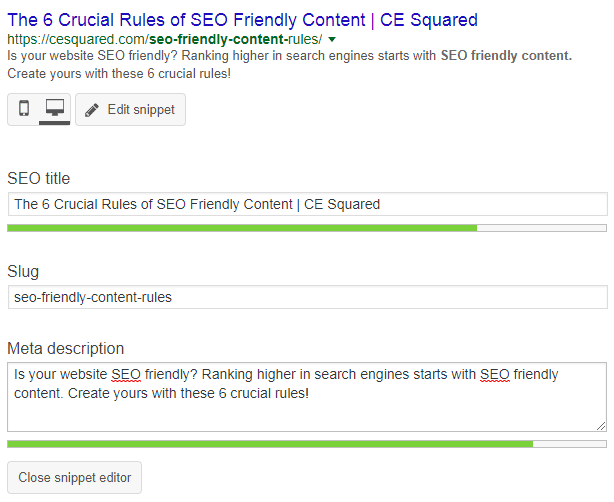SEO friendly content is your website’s ticket to a higher position in search engine results and exposure to new users. Lucky for you, crafting SEO friendly content may be easier than you think!
No, you don’t have to be a seasoned SEO expert to make friends with Google. Get in the good graces of all-powerful search engines by following these 6 crucial rules.
Rule #1: Be original.
If you’re recycling the same old text as every Tom, Dick and Harry – it’s time to return to the drawing board. Your readers don’t like ingesting repetitive content and neither do search engines.
Don’t be afraid to target keywords with 0-10 monthly searches. Sure, those keywords receive less traffic, but it’s worth ranking high for keywords with fewer searches than not ranking at all – especially if they bring in qualified traffic.
Rule #2: Optimize your titles and metas.
Is your website SEO friendly? Optimized titles and metas are an important feature of SEO friendly content.
Whenever possible, include keywords directly in the title and meta of each page. Since these are the previews users view in search engines, you should also be certain they entice clicks.
Free plugins like Yoast SEO make editing titles and metas easy as pie.

Rule #3: Avoid banned SEO tactics.
If you’ve ever considered engaging in SEO methods banned by search engines like Google, we have four words for you: it’s not worth it!
Not sure what’s banned? Take a look at the complete list Google has outlined under their Quality Guidelines. Using sneaky redirects, doorway pages, unrelated links and more can get your website blacklisted from search results.
Rule #4: Work for those backlinks.
Procuring links for your website is usually easier said than done. Even so, credible, relevant links remain one of the top ranking factors and it is certainly worth putting in the effort.
A few ways you can work for those backlinks:
- Write Guest Articles
- Create Infographics
- See Who Links to Your Competitors (free backlink checker on MonitorBacklinks.com)
- Promote Content on Social Media
- Give a Donation
- Leave Testimonials
Rule #5: Improve your website’s user experience.
Besides the obvious benefit of happier website visitors, user experience has a big impact on your bounce rate. This metric (measured in Google Analytics) is thought by many SEO gurus to have a direct effect on search engine rankings.
A bounce rate tracks the number of visits in which a user leaves your website from the landing page without browsing additional pages. To lower your website’s bounce rate, work towards improving user experience.
Faster page load times, shorter paragraphs, bullet points, proper formatting, and a foolproof navigation bar can all help in this effort.
Rule #6: Use the right keywords.
Why care about SEO friendly content at all if it attracts the wrong visitors? To attract the right ones, delve into what the motive is of users searching specific keywords.
Imagine you own a surfboard shop. It probably wouldn’t be worthwhile to focus on a vague keyword like ‘surfboard’. Besides being highly competitive, the searcher could have any number of intentions – perhaps they’re simply looking for surfboard images to use in a project or they’d like to know history of surfboards.
If you instead use long tail keywords like ‘surf shop in orlando’ or ‘women’s beginner surfboards’, your chances of attracting qualified visitors increase tenfold.
Takeaway
Following these guidelines will help you build an effective framework for your SEO friendly content, but it’s important never lose sight of the main goal: delivering value to your readers.
When in doubt, go for quality.
Not sure what to write about? Learn how to take a data-driven approach to find new topics ideas for your website.

Thanks for this wonderful post. SEO is an great part of blogging, and helps to get constant flow of traffic over long periods of time. Both on page and off page optimization are equally important, but I have been trying to learn more and more about on page optimization. Learned quite a few rocking tips on how to write SEO optimized posts.
Thanks bro.